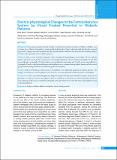Please use this identifier to cite or link to this item:
https://hdl.handle.net/20.500.14356/2305Full metadata record
| DC Field | Value | Language |
|---|---|---|
| dc.contributor.author | Malla, Neha | - |
| dc.contributor.author | Mahotra, Narayan B | - |
| dc.contributor.author | Shrestha, Lava | - |
| dc.contributor.author | Joshi, Sajun Narayan | - |
| dc.contributor.author | Gurung, Sanyukta | - |
| dc.date.accessioned | 2023-07-31T06:10:31Z | - |
| dc.date.available | 2023-07-31T06:10:31Z | - |
| dc.date.issued | 2022 | - |
| dc.identifier.citation | MallaN., MahotraN. B., ShresthaL., JoshiS. N., & GurungS. (2023). Electro-physiological Changes in the Central Nervous System by Visual Evoked Potential in Diabetic Patients. Journal of Nepal Health Research Council, 20(4), 947-951. https://doi.org/10.33314/jnhrc.v20i4.4334 | en_US |
| dc.identifier.issn | Print ISSN: 1727-5482; Online ISSN: 1999-6217 | - |
| dc.identifier.uri | https://hdl.handle.net/20.500.14356/2305 | - |
| dc.description | Original Article | en_US |
| dc.description.abstract | Abstract Background: Increasing sedentary lifestyle in today’s world has increased the prevalence of Diabetes Mellitus. Loss of vision due to diabetic retinopathy is a major public health burden. Visual evoked potential identifies the neuronal degenerative changes in chronic metabolic disorders specially Diabetes Mellitus. The study aimed at evaluating changes in visual evoked potential waves in diabetic patients. Methods: This is a cross sectional comparative study consisting of 90 participants, out of which 60 were diabetic patients and 30 were non-diabetic control group. Among diabetic patients, 30 were without retinopathy, 10 with mild non-proliferative retinopathy, 10 with moderate non-proliferative retinopathy and 10 with severe non-proliferative retinopathy. Visually evoked potential latencies and amplitudes were compared among diabetic patients and the control group and also among individuals with different grades of retinopathy. Results: Delay in P100 latency and decrease in its amplitude were statistically significant in diabetic patients. The changes in P100 latency, P100 amplitude and N75 latency were also significant in different grades of retinopathy. Conclusions: There are statistically significant changes in visually evoked potential in diabetes patients. Visual evoked potential is a useful, non-invasive investigation which can establish the central nervous system neuropathy in diabetes at an early stage of the disease. So Diabetic retinopathy can be prevented due to early detection of neuropathy by visual evoked potential test Keywords: Diabetes mellitus; diabetic retinopathy; visual evoked potential | en_US |
| dc.language.iso | en | en_US |
| dc.publisher | Government of Nepal; Nepal Health Research Council; Ramshah Path, Kathmandu, Nepal | en_US |
| dc.relation.ispartofseries | Oct-Dec, 2022;4334 | - |
| dc.subject | Diabetes mellitus | en_US |
| dc.subject | Diabetic retinopathy | en_US |
| dc.subject | Visual evoked potential | en_US |
| dc.title | Electro-physiological Changes in the Central Nervous System by Visual Evoked Potential in Diabetic Patients | en_US |
| dc.type | Journal Article | en_US |
| Appears in Collections: | Vol 20 No 04 Issue 57 Oct-Dec, 2022 | |
Files in This Item:
| File | Description | Size | Format | |
|---|---|---|---|---|
| 4334-Manuscript-32176-1-10-20230720.pdf | Fulltext. | 208.52 kB | Adobe PDF |  View/Open |
Items in DSpace are protected by copyright, with all rights reserved, unless otherwise indicated.
